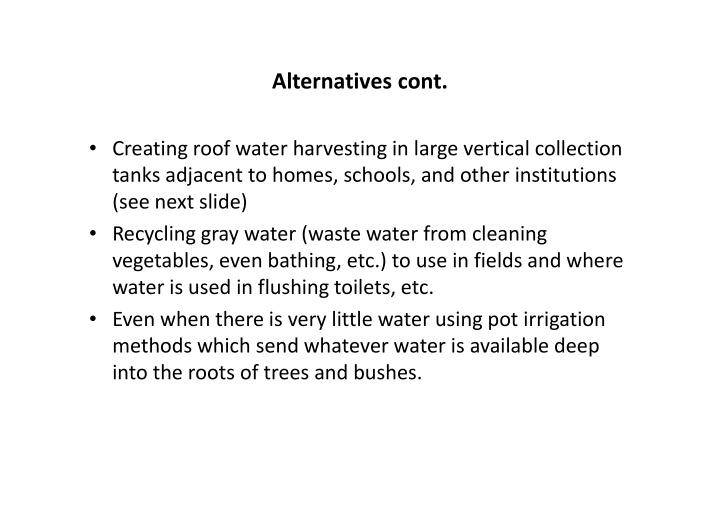



Alternatives cont. • Creating roof water harvesting in large vertical collection tanks adjacent to homes, schools, and other institutions (see next slide) • Recycling gray water (waste water from cleaning vegetables, even bathing, etc.) to use in fields and where vegetables, even bathing, etc.) to use in fields and where water is used in flushing toilets, etc. • Even when there is very little water using pot irrigation methods which send whatever water is available deep into the roots of trees and bushes.
Household water conservation tank
Another method of of water conservation: Using a pot to slowly drip water on the roots of trees In the driest areas of In the driest areas of Andhra Pradesh, the DDS is encouraging these plants. Surprisingly, these plants are often extremely hardy and have good yields.
SRI growing methods • And of major significance, making use of new technologies such as the system of rice intensification (SRI) to save on water usage and simultaneously produce much larger and simultaneously produce much larger yields. Recently the SRI method has been expanded to numerous other crops.
An SRI field soon after transplanting, with some water in field
SRI field after water has dried up overnight
Scientist from NGO showing SRI field owned by a female farmer
Problems with privatization It would be a disaster if water privatization were to come into effect, because the poor and • even the average middle class person can simply not afford to pay for water along with all other expenses. In rural areas it would mean the end of small family farming. Has been noted by P. Pankarajan that in India, privatization not only makes safe water • unaffordable for the impoverished and vulnerable populations Since poor communities offer no margins for the water companies to make profits. Furthermore in order to maximize profits once a corporation is given the right to a body of • water they can deplete the water body at a rate faster than is replenishable. Coca Cola has done this in several places in India including two of the southern States I am reporting on. done this in several places in India including two of the southern States I am reporting on. Public control of water is essential at a time of greater crisis. Fighting organizations like the • WB, WTO and IMF thus is essential. It is the only way to avoid compromising water quality and of avoiding the potential export of Bulk Water (several companies are already doing this in peri-urban villages) to sell in Chennai. Potential for corruption is enormous. People do recognize how privatization endangers the • fundamental rights of people as envisaged in the Indian Constitution. People realize this as do many politicians, which has been the main thing holding it back. • Hopefully, people will continue to fight for their water rights. Some State government officials are on the side of the poorer farmers (possibly because their • own relatives are small farmers). This could help their cause .
Government, Large International NGOs, and Central Govt. Funding Sources • Some State Governments are now paying attention to water issues even though there is little official recognition that drought is expected to get worse due to global warming. • State budgets for water conservation have increased • State budgets for water conservation have increased • Much of this state money is being given to grassroots NGOs to carry out State endorsed programs • International NGO’s such as OXFAM, or European countries AID programs, e.g. one such program in Karnataka is financed in part by Luxemburg.
Which Programs seem to be working best • From what our project as well as most of the literature I have examined show, those programs which give a prominent role to the local community seem to be doing the best. • Furthermore, as I noted in my AAA talk, where the grassroots NGOs have people on the ground who take time in explaining things, where they help with reorganizing or re-inspiring things, where they help with reorganizing or re-inspiring citizen groups this works best. For example, RASTA, with funding from CAPART (a Central Government Institution under the Ministry of Rural Development) found new enthusiasm among the citizen groups to re-green a river ecosystem planting bamboo, elephant grass, reeds etc. as well as constructing the check dams mentioned before. If river banks are left alone, they recover and the natural vegetation helps
Cont. • To filter debris during the annual monsoon flooding. Once RASTA did this with local people in a few sites, the following year many more local people came forward to help with this. • Similarly, ICRA’s small local ponds started in only a few farmer’s lands the first season, provided a strong positive farmer’s lands the first season, provided a strong positive model for others. • Thus, small scale, successful programs for water conservation are often the best way to promote programs that work and capture people’s energies and hard work.
One role for an Anthropologist • As noted in our original report for the Netherland’s Embassy, this material needs to be widely disseminated to a wide variety of people people • To eventually set up a network through which NGOs and the village farmers jointly can learn from one another especially to learn visually by looking at what other NGOs and farmers are doing
Recommend
More recommend